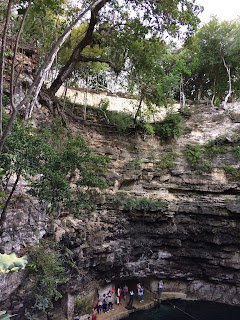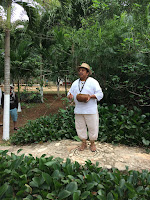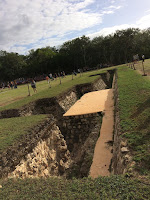Mayan Cities
~ Aaron
 |
| Kukulkan Temple sits at the center of the Mayan city, Chichen Itza |
We visited 3 very interesting Mayan cities. Along the way, all of us stopped at a Mayan shaman's house (who was the Mayan doctor). We saw Coba, which contains the only Mayan pyramid anybody can still climb. Chichen Itza is probably the most famous in all of them. Tulum was a Mayan village for the rich. Many human sacrifices were performed in these 3 places. Once you know about all these 3, wouldn't you agree they're quite historic?
Visiting the Mayan shaman was very awesome. The doorway showed a picture of a Mayan god called Kukulkan, meaning feathered snake. The shaman performed an ancient Mayan ritual for cleansing spirits. This was done by burning wood, adding some sweet smelling powder, and making everybody smell the smoke. He also gave us some special water, and we rubbed it on our faces for great studying. This is how excellent the Mayan shaman was.
The Mayan village shaman
City of Coba
Coba was very amazing. It is an ancient Mayan city on the Yucatan Peninsula, located in the Mexican state of Quintana Roo. There are many paths that start here and end at other Mayan cities. Coba could be counted as the center of all Mayan cities. The Mayan ball court in Coba was much different than the one in Chichen Itza. Instead of straight walls, the walls of the Coba ball court were diagonal. Climbing the temple at Coba was very scary. I looked down every few steps going up and every time, I felt more and more scared. After about 70 steps, I was already above the treetops! I reached the top of the 140-foot high temple by climbing its 120 stairs. This tallest Coba temple is surrounded by the jungle. I feel so proud to stand on top of the temple, look over the jungle. Climbing down was much harder. We had to walk down in a zigzag or sliding on our bottoms. It felt very nice climbing Coba's temple.
Climbing down from the main temple of Coba,
also a Mayan Pyramid
 |
| A Mayan ball court in Coba See the slanted walls? |
 |
| A Mayan ball court in Coba |
| A carving in the Coba ball court |
 |
A skeletal head rock
at the center of the Coba ball court |
 |
| A section of the Coba ball court wall |
 |
| Mayan ruins at Coba |
 |
| A Mayan temple at Coba |
 |
| Me swimming at a cenote |
I'm swimming at the Coba Cenote
City of Chichen Itza
 |
| The Kukulkan Temple of Chichen Itza |
 |
Ruined Chichen Itza city wall
sitting at the entrance
|
The Kukulkan Temple is sort of like a calendar for the Mayas:
- There are 9 big steps on the main temple, and a staircase divides them into 2 halves. This makes the 18 months in the Mayan calendar with 20 days per month. 18 months x 20 days = 360 days. Every year, the calendar is 5 days behind. To make this up, the Mayans had to add 1 month (another August) every 4 years. 5 days x 4 years = 20 days. The people born in the 6th through 10th days of that extra month were used as human sacrifices.
- There are 91 steps on each of the 4 sides, and another step at the top for a total of 365 (365 days per year). 91 days x 4 seasons +1 = 365 days
- There are 7 dark triangles at the Kukulkan Temple, and to the bottom left of the lowest triangle, a snake head. These dark triangles can only be viewed when directly facing one side of the temple and looking at the left. They are caused by the sides of the staircase on that side. At sunset, 1 triangle completely becomes bright every 15 minutes, then starts to fade. Using the direction the triangles faded in, they were able to tell when to plant crops and harvest them.
 |
| The Temple of Warriors |
 |
Some of the 200 columns standing at the Temple of Warriors
|
 |
| Warriors carved on square columns at
the Temple of Warriors
these are all circular |
Chichen-Itza warrior columns
beside the Temple of Warriors
The Chichen Itza ball court is very large. The Mayans had to use echoes to make sure each side knew what was happening. If you face one side of the court, you'll find that the rocks on the left side are smaller than the right side. This is the same on the other side too. That helps create the echoes. The walls are vertical in this ball court, but with a small platform jutting out on the bottom. The captain of each team stands on the platform so can fire the ball into the hoop, but the other players must first pass the ball to their captain.
City of Tulum
Tulum was a very prosperous city in Mayan era. Like all Mayan cities, it is close to a cenote, as a source of water. However, the Tulum's cenote is so close to the sea, the water is salty. Every day, people have to carry through 2 miles of jungle just to get to freshwater! Tulum is built right on a cliff looking over the Caribbean Sea, so the rich living there had a beautiful view. The Great Lord of the Mayas lived here in Tulum, of course, during the Mayan era. It was a busy harbor and trading center in Mayan era. In many mythologies, Venus is a female, but the Mayan Venus is a male! His statue is right above the entrance to the temple used for sacrifices. They used nearby plants as medicine to heal the residents.
The Great Lord Palace was where one of the most famous people in Tulum lived. However, it is only called "Palace" because it is where the Great Lord lived. It consists of 7 large rooms covered with a flat roof supported by columns. The roof was made of crossed wooden beams and a mix of gravel, limestone powder, and sand called "calcrete".
 |
The Temple of the Descending God
|
 |
| Tulum city |
Tulum means wall in the Mayan language. From its name, it's obvious Tulum was a walled city in the Mayan era. The Tulum wall was very strong at one point. Its height varied, as it was built on the land. It could have been used as a defense or to show a sacred area. The shape was in a rectangle, but it only had 3 sides because a cliff formed a natural fourth side. It has one west entrance, two south entrances, and 2 north entrances.
 |
| The Temple of Frescoes, Tulum |
 |
| The Temple of Frescoes, Tulum |
 |
| Mayan ruins |
 |
Temple of the Wind God (Temple of Kukulkan), Tulum
|
 |
Temple of the Wind God
Tulum
|
 |
| Mayan ruins at Tulum |
 |
| Mayan temple |
 |
| The Caribbean Sea at Tulum |
 |
| The Caribbean Sea at Tulum |
 |
| The Caribbean Sea at Tulum |
 |
| The Caribbean Sea at Tulum |
 |
| The Caribbean Sea at Tulum |
Tulum, a Mayan city built beside
the Caribbean Sea cliff
The Mayan human sacrifices were very entertaining to the Mayan people. We learned there are multiple ways the Mayans sacrificed people. However, some of the sacrifices were simply enemy soldiers. Most of the rest were the people born in the "unlucky" 5 day Mayan month from today's August 6th to 10th. The ultimate winner of the Mayan ball games was also sacrificed to ensure fertile soil the next year. In some sacrifices, hearts were pulled out of people after their spinal cords were broken. Some heads were cut off. These Mayan sacrifices sure would be excellent to watch in Mayan era.
These 3 places includes full of Mayan history. Coba was probably one of the most famous cities during Mayan era, since paths from many cities started here. Chichen Itza is one new 7 wonders of the world. Tulum was a very important city for Mayans as it was used for observatory, harbor, market and where the great lord lived. The human sacrifices indicates the culture of Mayas. I wish I could have stayed at these 3 places much longer.
Swimming at the Coba Cenote
The Coba Cenote
At the Coba Cenote
 |
| A Catholic church on our way to Chichen Itza |
 |
| Turkeys at a Mayan village |
 |
| Peacock at Coba |
 |
| A sunset on the way back from Tulum |
  |
| Young coconuts |
 |
A cenote close to Chichen Itza
|
 |
A cenote close to
Chichen Itza
|
 |
A cenote close to
Chichen Itza
|
 |
A cenote close to
Chichen Itza
|
 |
A cenote close to
Chichen Itza
|
 |
Fish in the cenote
close to Chichen Itza
|









































No comments:
Post a Comment